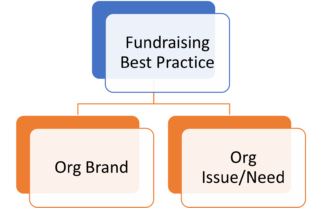Limiters are Liberating
Opportunity cost is almost certainly your biggest expense in an agency or charity. It’s the value and upside of the path not taken versus your chosen route. And your alternative isn’t a single path, it’s countless ones, a veritable multiverse of different endings.
Consider this choice, attraction or persuasion fundraising. This probably ain’t in your top 100 list of choices because it’s mostly a default with 99% of the sector doing the latter:
- Persuasion is convincing potential donors to contribute to your cause, often through emotive appeals and urgent calls to action.
Persuasion aims to align a donor’s perspective with the cause and the message taxonomy is something akin to the graphic below. The donor is missing. We put our respective versions of fundraising best practice into action against what’s known, usually only the brand, issues and programs of the organization.

Contrast this with attraction fundraising.
- Attraction is aligning with donors’ existing values and passions and fostering organic support.
To do this requires adding extra layers for a fuller, Donor Taxonomy:
- Organizational brand: It matters and largely determines what donor Identities are on your file. In this example, a Military Identity fits the brand.
- Identity: A version of ourselves. We each have lots of identities. Our separate Identities have separate values and goals. A big part of fundraising messaging is showing the donor that supporting the charity is in keeping with their values.
- Personality. Not all people in a given Identity are the same. Different personalities require different messaging if we care about showing em’ we know em’.
- Moral Lens: A lot of charitable giving involves people making a moral judgement. Is supporting this cause the right thing to do? Different Personality types tend to use different moral lenses for different charities.
- Emotion: “Make it emotional.” This dictum isn’t very useful. Emotion is more refined and shouldn’t be left to guesswork. There are certain emotions that work better with certain moral frames.
At first blush this feels like so much extra. To some fundraisers this feels too complicated. I’d argue it simplifies. It constrains choices by providing detailed guidance. The limiters are liberating of your time. The opportunity cost is lesser if only because it takes far less time to write an appeal when it’s paint by numbers vs. blank canvas.
But the opportunity cost cuts two ways. You spend an awful lot of time debating the infinite number of choices in the Persuasion world. This breeds inefficiency but it also breeds ineffectiveness. How so?
You’re living in a one-size-fits-all world since the donor is missing. Your blank canvas approach is producing an abstract masterpiece and half your audience wants bowl of fruit realism.
Here’s a real example. You can follow the paint by numbers color coding to see how damn near every word was selected to match this unique donor messaging profile (the one highlighted in green).
With this approach, you can paint your way to both versions. The Limiters are liberating and the more the better.

Kevin



This all makes great sense and is quite convincing, but I run up against a wall when considering how i could systematically gather data beyond identity.
Hi John. thanks for reading and commenting. We can append Personality Tags to any constituent file, meaning any Bloomerang customer can know which supporter is Agreeable, which is Conscientious etc. This is done using 3rd party data as raw ingredients and proxy and our custom “recipes” or formulas to turn raw ingredients into usable biz intel. We also have easy to follow, one pager “cheat sheets”, one per trait, showing what words to use, images, formats, tone etc. Hope that addresses your comment?